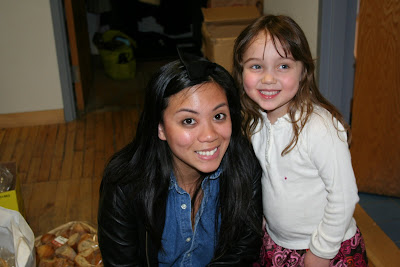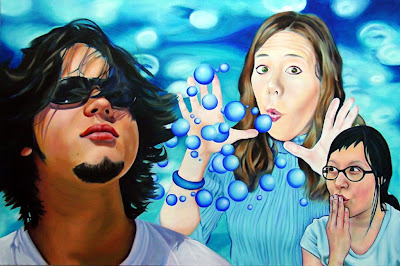DestinAsian had been forged in the wake of the renewed political activism that followed Sa-i-gu (1992 LA Riots), the ongoing sense of injustice over the Vincent Chin murder (1982 Detroit), and in the footsteps of the larger NY and SF Asian American Arts organizations (Basement Workshop, Godzilla, Kearney Street Workshop). By the time FAAIM came on the scene, the hey-day of multiculturalism from the 80s and 90s was beginning to wane. It wasn't enough to simply organize exhibitions showcasing Asian American art (read Alice Yang's 1998 essay "Asian American Exhibitions Reconsidered" in Why Asia? for a detailed debate on these issues). Gone too were those punk anti-slick political protest aesthetics of the 60s and 70s (see "Is there an Asian American Aesthetics?" Ed. Augie Tam and Gargi Chatterjee 2007). Increasingly we were breaking through to the mainstream. Remember all the APIA success stories heralded by A Magazine and the hype around Justin Lin's 2002 Better Luck Tomorrow? Art school and film school were a given. I remember filmmaker and musician Romeo Candido at one of our "TalkBack" sessions schooling us on the importance of being "on point" with our work. Foregrounding issues of race was not enough. Perfecting our craft was expected and our curatorial premises had to be critical (at least in theory....goofiness seemed to rule the day many times).
This wasn't the old community arts movement anymore. There were pros and cons to this shift. I didn't find myself surrounded as much by multiple generations. In the early years you really would find senior citizens and college kids working together on art shows. Now the movement was decidedly young. Enter the APIA arts generation of Giant Robot. The other shift we began to see was the increase in transnationlism and emphasis on diaspora in the arts. Now we were hip and global cosmopolitans connected 24/7 via Starbucks coffee, blogs, and listservs (this was before Facebook and Twitter et al)!
Then enter 9/11 and the Asian American Artists Collective Chicago (2001-2005) [along with Mango Tribe, YAWP! Project A and Kitchen Poems]. The time had come for us to speak up. It was important for us to stand in solidarity with our fellow Muslim brothers and sisters and Anida Yoeu Ali and Marlon Esguerra of I was Born with Two Tongues led the way. We wanted to warn America not to make the same mistake as we did in WWII with the internment of Japanese Americans. The face of who was involved with Asian American arts had begun to shift. The children of the post-1965 wave of immigrants from all over Asia had come of age. Chinese, Japanese, and Filipino Americans have long been central to Chicago's Asian American arts community but now they were joined by Koreans, Cambodians, Vietnamese, Loations, Hmong, and growing number of transracial Korean Adoptees, mixed race Asians like me and South Asians from India, Pakistan and Bangladesh.
Naturally there were tensions and fault lines in these groups. Usually this had less to do with ethno-racial issues (although equity and parity and gender equality needed to be addressed) and more to do with affiliations by discipline (film, art, music, spoken word, literature, performance etc.) and the extent to which artists wanted or needed to be involved in directly political content or to be defined under the umbrella of "Asian America." I think it's important to note both the limitations and the benefits of pan-Asian American interdisciplinary arts organizing. It is still important for ethnic specific arts organizations such as Pintig and Desilit the Chicago Filipino American Film Festival to exist to build and reflect specific communities and to foreground thier histories, stories and issues. It has also been useful for Asians in American to work across ethnic lines in groups devoted to specific disciplines (comedy, theatre, music...) such as: Stir Friday Night, Silk Road Theatre Project, A Squared Theatre Workshop, the Asian Improv aRts Midwest Asian American Jazz Festival.
Depending on how you look at things, Chicago's Asian American art scene has been blessed and burdened by it's unique characteristics. Too little funding and institutionalization has instilled an underground DIY culture of volunteerism (and burn out and maxing of your personal credit cards for the sake of art). Colleges such as the School of the Art Institute of Chicago bring a constant flow of new artists from around the world, Korea in particular, who come to this city to make their mark in the arts. As a center for education, it also means that many of these same artists just pass through Chicago on their way to careers in NY or LA or back in Korea, Japan, or China etc. This helps extend our networks but it also means that some of the best don't stay. We suffer from "Second City" syndrome. Where are the funders and collectors? This all makes us tough and a little skeptical of the marketplace. We are perfectly at home curating a show in a gritty alternative space as well as a polished gallery. We can be the directors and have no qualms about making lunch for the crew. We'll be on stage and run the AV and PR and check your coat!
But surely it's better on the coasts? Because we don't have the shear numbers of ethnic specific populations that you see on the coasts, we are more apt to reach across ethnic lines to work together on pan-Asian projects and to also find deep and meaningful affiliations with other communities of color. Chicago's strengths in theater, jazz, indie rock and spoken word have dominated the scene. All of these factors have helped create our unique arts community.
On March 20, 2010 the Foundation for Asian American Independent Media (FAAIM) held their first ever fundraiser for the Asian American Showcase. It's taken a while to ask for the $! Special thanks to Tim Hugh for directing the showcase for the past 10-years!
Here are some snapshots from the event held at Andrew Bae Gallery 300 W. Superior Chicago, IL http://www.andrewbaegallery.com/
http://www.faaim.org/fundraiser/





















